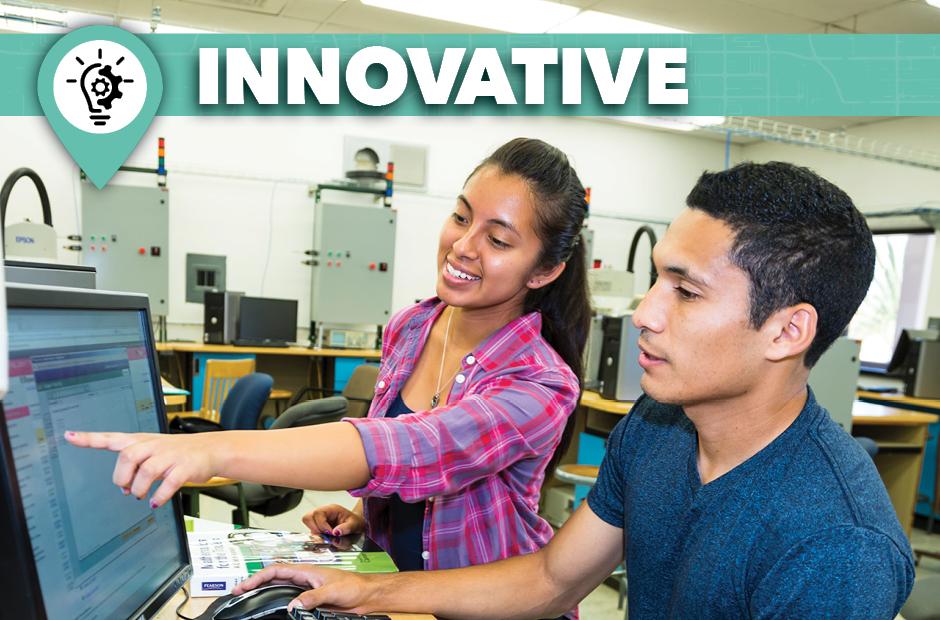Innovative
GOAL: Through implementing innovative approaches, LBCC will achieve equitable student outcomes, address emerging industry needs, and promote sustainability.
Continue to enhance and offer the Cultural Curriculum Audit to close equity gaps in course success
- Implement all phases of the Cultural Curriculum Audit per the Quality Focus Essay
Address the needs of the local and regional labor market through curriculum development
- Continue to examine regional data and reports for living-wage industry growth to support curriculum development and modification
- Continue to educate students on career opportunities in relation to the programs offered on campus
- Investigate the development of industry advisory committees for non-CTE programs to inform curriculum development and modification
Continue to work toward the attainment of environmental justice by serving as a leader in upgrading facilities to be environmentally sustainable, accessible, welcoming, and student-centered
- Continue to implement the Integrated Energy Master Plan in alignment with the Facilities Master Plan
- Improve the accessibility of all facilities on campus
Continue to invest in state-of-the-art technology to enhance student learning and improve business processes
- Continue to leverage technology investments and enhance online services that were implemented in response to the pandemic in support of students and employees at the College
- Utilize and leverage cloud-based solutions to build efficiencies and ensure data security
- Investigate and explore new technologies on an on-going basis to improve business processes
- Continue to support student and employee access to and successful use of College technology
- Continue to provide students with access to technology systems and software needed for successful completion of coursework and educational goals
- Continue to explore and implement improvements to existing institutional technologies and software
Close equity gaps in persistence and course success to achieve equitable student outcomes
- Fully implement structured roadmaps with milestones and meta-majors
- Continue to offer programs, services, and academic supports in multiple modalities to meet student needs
- Support the development of fully online programs
- Develop z-degrees and increase usage of Open Educational Resources
- Continue to implement and support equity-focused faculty inquiry groups, across both CTE and non-CTE disciplines
- Implement creative strategies and supports to increase successful transfer-level math and English course completion for degree-seeking students within their first year and close equity gaps
- Continue to support completion counseling interventions and re-engagement strategies to support student persistence
- Continue to enhance student-centered scheduling practices
- Continue to analyze disaggregated course, program, and institutional student learning outcome data to identify and implement actions to improve student learning
- Identify ways to remove barriers inside and outside of the classroom so adult learners (+25 years of age) can attend class while managing other aspects of life (e.g., parent and me courses with kids doing schoolwork while parents are in class)
- Identify and implement additional strategies to increase FAFSA application submissions and increase awarding of Pell grants to students
- Expand and encourage opportunities for co-teaching across disciplines and amongst faculty of diverse backgrounds, cultures, races, identities, and abilities to promote authentic collaboration, celebrate diversity, and learn from one another to support equitable student learning and success
Offer and award student equity mini-grants and equity innovation grants annually to intentionally support race-conscious and equity-minded practices that close equity gaps
Success Outcomes – Innovative
Innovate for success:
- Increase course success rates to 74%
- Increase transfer-level English completion for degree-seeking students in the first year to 46%
- Increase transfer-level Math completion for degree-seeking students in the first year to 31%
- Increase fall-to-fall persistence rates for degree-seeking students to 55%
- Increase the number of degrees awarded to 3,365
- Increase the number of certificates of achievement awarded to 4,523
- Increase 3-year completion rates for first-time, full-time degree-seeking students within 150% of normal program completion time to 25%

